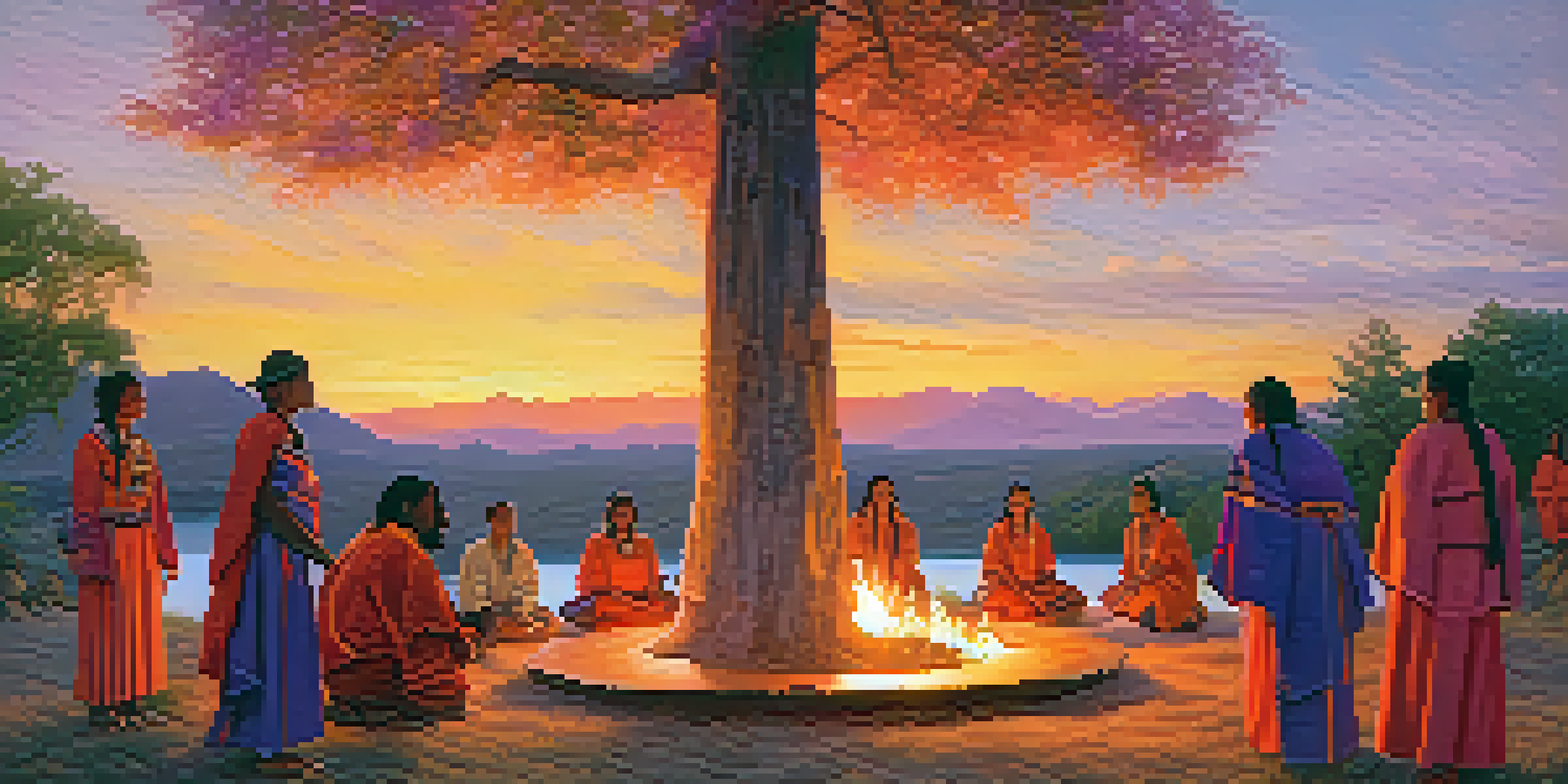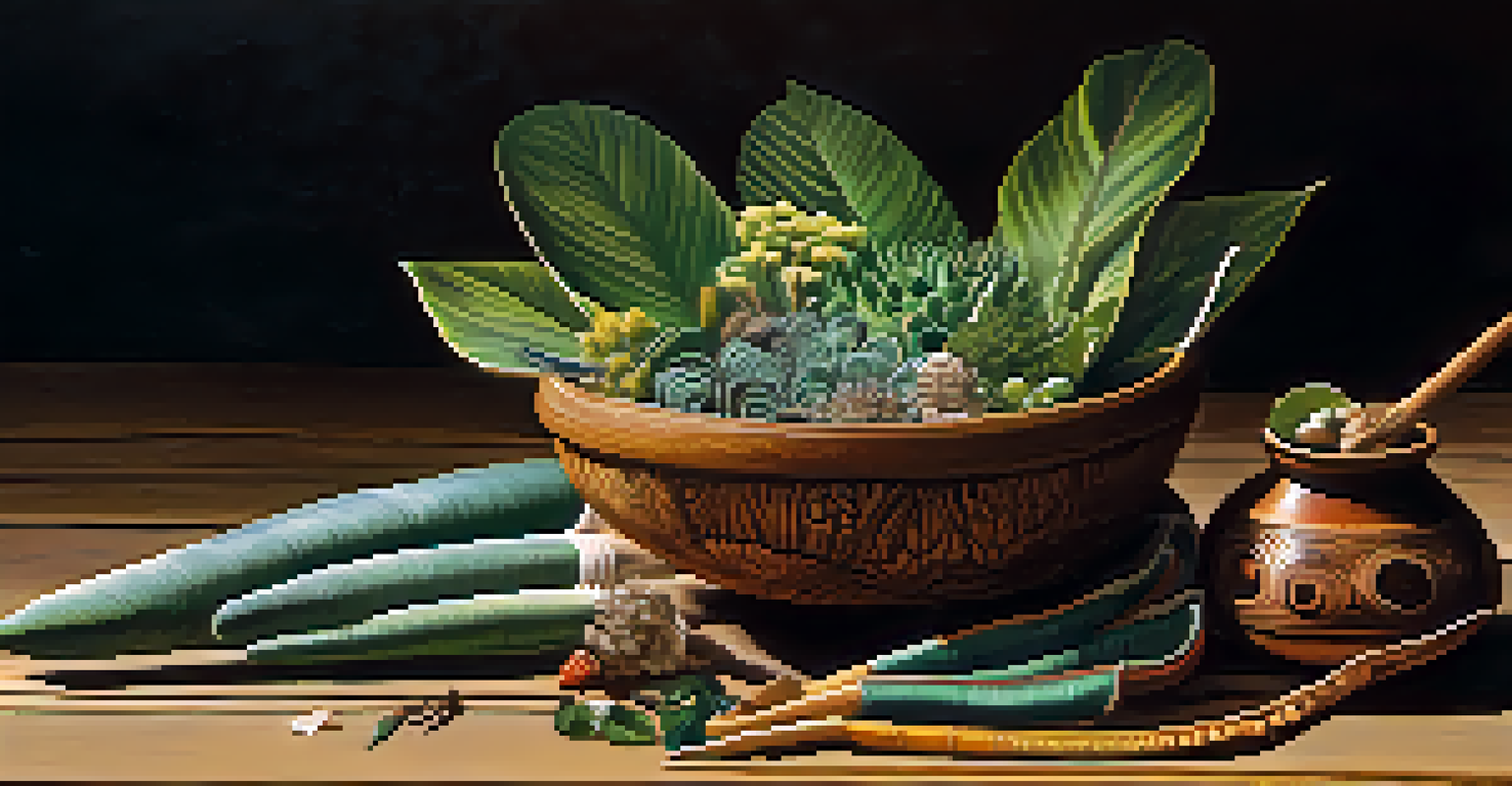Entheogens: Bridging Ancestors and Modern Indigenous Identity

Understanding Entheogens and Their Cultural Significance
Entheogens are substances, often derived from plants or fungi, used in religious or spiritual contexts. They have played a crucial role in indigenous cultures for centuries, serving as tools for introspection and connection to the divine. This practice is not merely about consumption; it's deeply intertwined with rituals, community bonding, and ancestral wisdom.
The plants are our teachers, and they are here to help us remember who we are.
For many indigenous people, these substances are viewed as sacred and carry the weight of cultural significance. They help link individuals to their ancestors and spiritual traditions, creating a sense of belonging and continuity. By understanding this context, we can appreciate the profound impact of entheogens on identity formation.
As modern society increasingly recognizes the therapeutic potential of these substances, it’s vital to honor their historical roots. Many indigenous communities are reclaiming their practices, ensuring that their cultural heritage is respected in contemporary discussions about entheogens.
Historical Use of Entheogens in Indigenous Cultures
Historically, entheogens have been utilized in various indigenous cultures across the globe, from the Amazon rainforest to North America. These practices often involve ceremonies led by shamans or spiritual leaders who guide participants through transformative experiences. Such rituals are designed to facilitate healing, insight, and connection with the spirit world.

In these contexts, entheogens are not just substances but sacred tools that foster communal ties and spiritual growth. For instance, the use of peyote by Native American tribes has been integral to their religious practices, emphasizing the importance of nature and spirituality. This serves as a reminder that these practices are about more than the substances themselves; they reflect a holistic worldview.
Entheogens' Cultural Importance
Entheogens are sacred substances in indigenous cultures, used for spiritual connection and community bonding.
As we explore these historical uses, it's crucial to recognize the intricacies of each culture's relationship with entheogens. Acknowledging their varied applications allows for a deeper understanding of how these practices continue to influence modern indigenous identity.
Modern Indigenous Movements and Entheogen Revival
In recent years, there has been a resurgence of interest in entheogens among modern indigenous movements. Activists are not only advocating for the preservation of traditional practices but also for the legal recognition of entheogens as essential to their cultural identity. This revival is often accompanied by a desire to educate both indigenous and non-indigenous communities about the significance of these substances.
Indigenous people have a right to their traditional medicines and practices, just as they have a right to their territory and culture.
Social media platforms and grassroots organizations have played a crucial role in this renaissance. They provide spaces for sharing experiences, knowledge, and resources, effectively creating a global dialogue around entheogens. This interconnectedness fosters solidarity among different indigenous groups, uniting them in their shared values and goals.
Through this revival, many indigenous people are reclaiming agency over their cultural narratives. They are crafting a modern identity that honors ancestral wisdom while engaging with contemporary societal issues, showcasing the adaptability and resilience of their traditions.
Entheogens and Personal Identity in Indigenous Contexts
For many individuals, engaging with entheogens can be a transformative experience that shapes their personal and cultural identity. These substances often facilitate deep introspection and connection to one's roots, leading to a greater understanding of self and community. This journey can help individuals reconcile with their heritage and embrace their indigenous identity more fully.
Personal stories abound, illustrating how entheogen experiences have catalyzed healing and empowerment. For instance, individuals recount moments of clarity where they felt a direct connection to their ancestors or the natural world. Such experiences not only reinforce personal identity but also strengthen ties to cultural heritage.
Modern Indigenous Movements Rise
There is a growing revival among indigenous communities to reclaim entheogenic practices and advocate for their cultural significance.
However, this journey is not without challenges. Many individuals grapple with the complexities of navigating modern life while honoring traditional practices. This tension highlights the need for supportive community structures that can help bridge these worlds.
Navigating Cultural Appropriation and Respect
As interest in entheogens grows, so does the risk of cultural appropriation. It's essential to approach indigenous practices with respect and understanding, recognizing that these traditions are not commodities to be exploited. Many indigenous communities have expressed concerns about outsiders appropriating their sacred practices without acknowledging their significance.
To navigate this landscape, it's crucial for non-indigenous individuals to educate themselves about the cultural contexts surrounding entheogens. This means listening to indigenous voices, supporting their rights, and advocating for ethical practices. By doing so, we can foster a more respectful dialogue that honors the heritage of these communities.
Ultimately, this effort requires a commitment to building meaningful relationships with indigenous peoples. By respecting their traditions and supporting their rights, we can contribute to a more equitable and just understanding of entheogens in today's society.
The Therapeutic Potential of Entheogens in Modern Society
Recently, scientific research has begun to explore the therapeutic potential of entheogens for mental health treatment. Studies have indicated that substances like psilocybin and ayahuasca may offer new avenues for addressing conditions such as PTSD, depression, and anxiety. This growing interest reflects a broader societal shift towards understanding the mind-body connection.
While the therapeutic benefits are promising, it's essential to approach this research with caution and respect for indigenous traditions. Many practitioners advocate for a framework that integrates traditional wisdom with modern scientific methods, ensuring that the cultural significance of entheogens is preserved. This could lead to an enriched understanding of both the mind and spirit.
Therapeutic Potential and Caution
Research into entheogens' mental health benefits highlights the need for respectful integration of traditional wisdom with modern science.
By bridging these worlds, we can create a holistic approach to healing that honors the past while addressing contemporary needs. This integration can also empower indigenous communities, providing them with opportunities to share their knowledge and practices in a way that respects their heritage.
A Future of Collaboration and Mutual Respect
Looking ahead, the future of entheogens in the context of indigenous identity hinges on collaboration and mutual respect. As more people recognize the importance of these substances, it becomes vital to engage with indigenous communities in meaningful ways. This means prioritizing their voices and ensuring they have agency over how their practices are represented.
Collaborative efforts can lead to a shared understanding of both the cultural and scientific dimensions of entheogens. By working together, we can promote respectful practices that honor indigenous knowledge while exploring new therapeutic possibilities. Such partnerships can also serve to educate broader society, dismantling stereotypes and misconceptions surrounding indigenous traditions.

Ultimately, fostering a climate of respect and collaboration can empower indigenous communities to reclaim their narratives. By doing so, we honor their past while paving the way for a future where their identities and practices are celebrated and preserved.